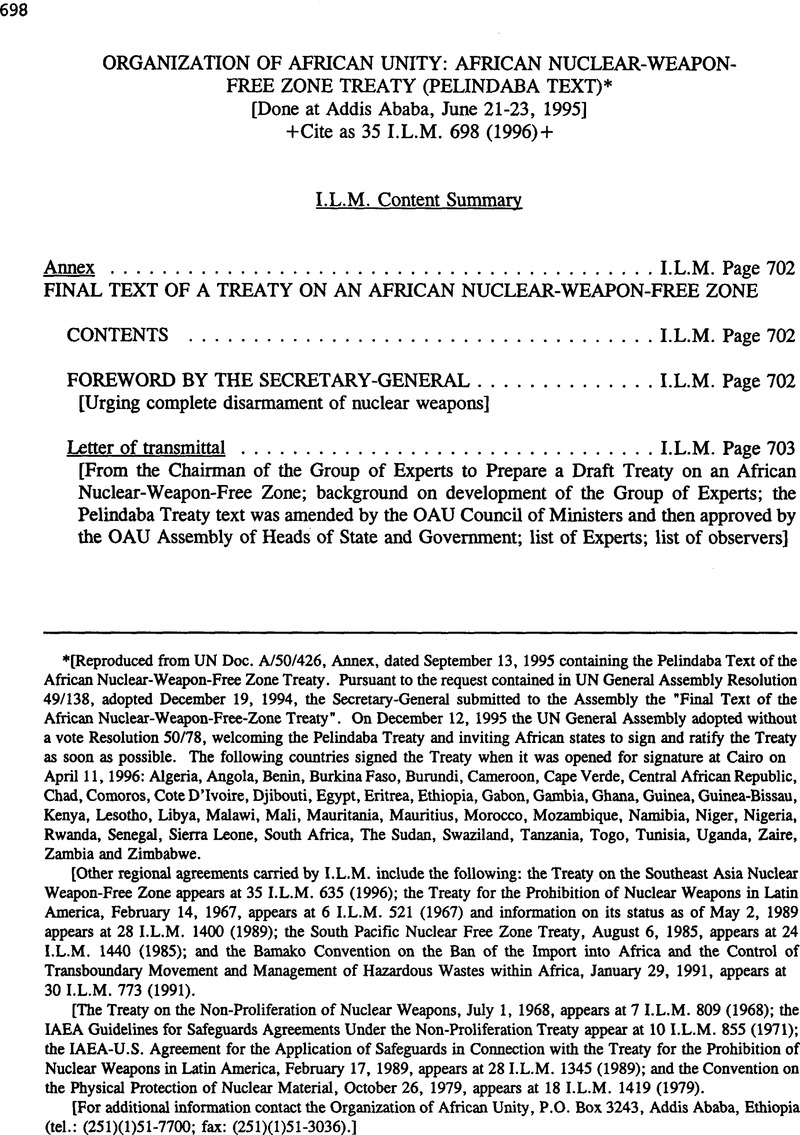Published online by Cambridge University Press: 27 February 2017

* [Reproduced from UN Doc. A/50/426, Annex, dated September 13, 1995 containing the Pelindaba Text of the African Nuclear-Weapon-Free Zone Treaty. Pursuant to the request contained in UN General Assembly Resolution 49/138, adopted December 19, 1994, the Secretary-General submitted to the Assembly the “Final Text of the African Nuclear-Weapon-Free-Zone Treaty”. On December 12, 1995 the UN General Assembly adopted without a vote Resolution 50/78, welcoming the Pelindaba Treaty and inviting African states to sign and ratify the Treaty as soon as possible. The following countries signed the Treaty when it was opened for signature at Cairo on April 11,1996: Algeria, Angola, Benin, Burkina Faso, Burundi, Cameroon, Cape Verde, Central African Republic, Chad, Comoros, Cote D‘lvoire, Djibouti, Egypt, Eritrea, Euiiopia, Gabon, Gambia, Ghana, Guinea, Guinea-Bissau, Kenya, Lesotho, Libya, Malawi, Mali, Mauritania, Mauritius, Morocco, Mozambique, Namibia, Niger, Nigeria, Rwanda, Senegal, Sierra Leone, South Africa, The Sudan, Swaziland, Tanzania, Togo, Tunisia, Uganda, Zaire, Zambia and Zimbabwe.
[Other regional agreements carried by I.L.M. include the following: the Treaty on the Southeast Asia Nuclear Weapon-Free Zone appears at 35 I.L.M. 635 (1996); the Treaty for the Prohibition of Nuclear Weapons in Latin America, February 14, 1967, appears at 6 I.L.M. 521 (1967) and information on its status as of May 2, 1989 appears at 28 I.L.M. 1400 (1989); the South Pacific Nuclear Free Zone Treaty, August 6, 1985, appears at 24 I.L.M. 1440 (1985); and the Bamako Convention on the Ban of the Import into Africa and the Control of Transboundary Movement and Management of Hazardous Wastes within Africa, January 29, 1991, appears at 30 I.L.M. 773 (1991).
[The Treaty on the Non-Proliferation of Nuclear Weapons, July 1, 1968, appears at 7 I.L.M. 809 (1968); the IAEA Guidelines for Safeguards Agreements Under the Non-Proliferation Treaty appear at 10 I.L.M. 855 (1971); the IAEA-U.S. Agreement for the Application of Safeguards in Connection with the Treaty for the Prohibition of Nuclear Weapons in Latin America, February 17, 1989, appears at 28 I.L.M. 1345 (1989); and the Convention on the Physical Protection of Nuclear Material, October 26, 1979, appears at 18 I.L.M. 1419 (1979).
[For additional information contact die Organization of African Unity, P.O. Box 3243, Addis Ababa, Ethiopia (tel.: (251)(l)51-7700; fax: (251)(l)51-3036).]